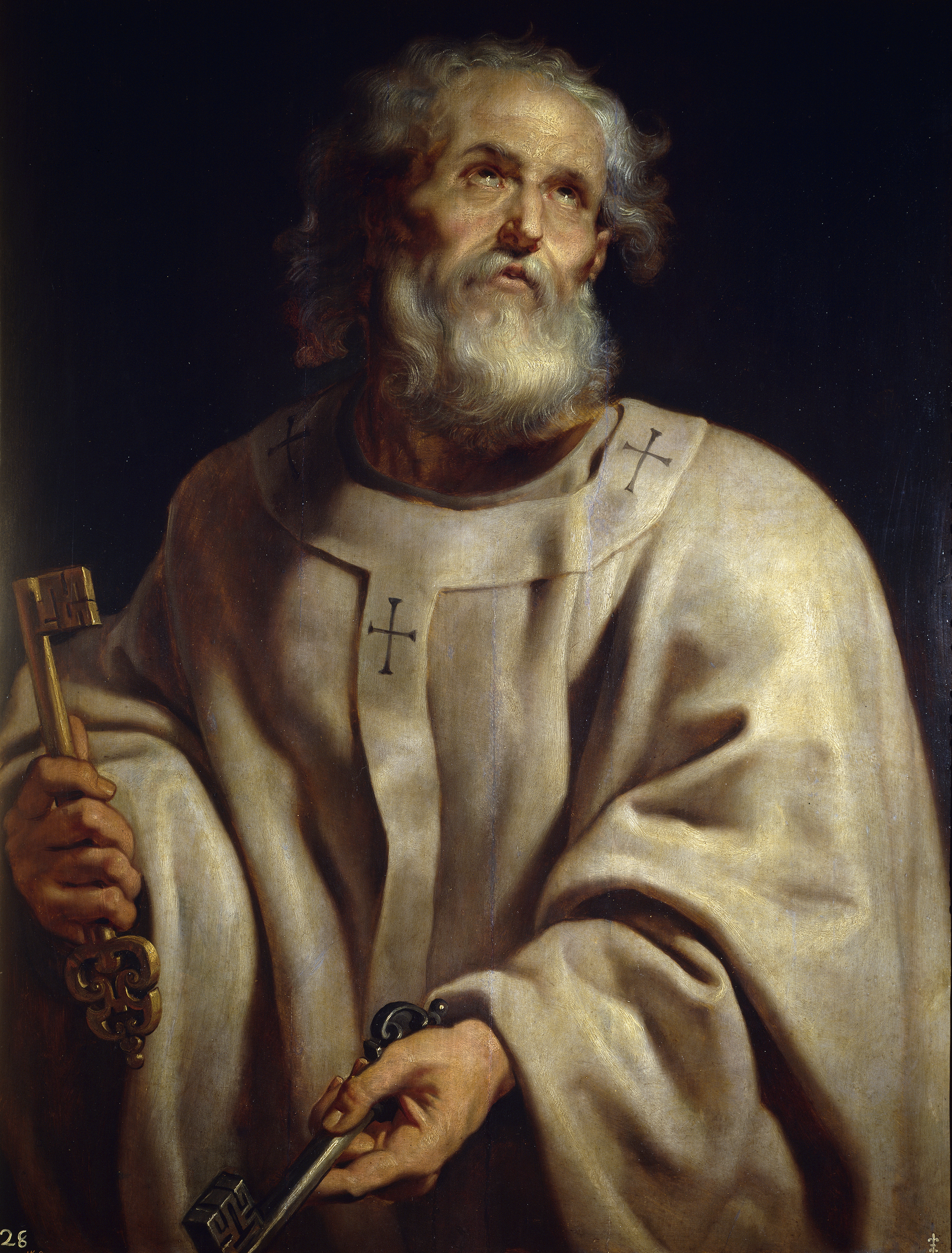
Saint Peter
Saint Peter[note 1] (died AD 64–68),[1] also known as Peter the Apostle, Simon Peter, Simeon, Simon, or Cephas,[6] was one of the Twelve Apostles of Jesus Christ and one of the first leaders of the early Christian Church. He appears repeatedly and prominently in all four New Testament gospels as well as the Acts of the Apostles. Catholic tradition accredits Peter as the first bishop of Rome—or pope—and also as the first bishop of Antioch.
For other uses, see Saint Peter (disambiguation).
Peter the Apostle
- First bishop of Rome (pope), according to Catholic and Eastern Christian tradition
- First bishop of Antioch, according to Eastern Christian and Catholic tradition
AD 30[1]
Between AD 64 and 68[1]
by Jesus Christ, AD 30
Between AD 64 and 68
Vatican Hill, Rome, Italia, Roman Empire[3][4]
John (or Jonah; Jona)
Yes, name unknown
- Main feast: Feast of Saints Peter and Paul (with Paul the Apostle) 29 June (Catholic Church, Eastern Orthodox Church, Oriental Orthodoxy, Anglicanism, Lutheranism)
- 18 January: Confession of Saint Peter (Anglicanism)
- 22 February: Chair of Saint Peter (Catholic Church)
All Christian denominations that venerate saints and in Islam
Pre-Congregation
Keys of Heaven, Red Martyr, pallium, papal vestments, man crucified upside down, vested as an Apostle, holding a book or scroll, Cross of Saint Peter
According to Christian tradition, Peter was crucified in Rome under Emperor Nero. The ancient Christian churches all venerate Peter as a major saint and as the founder of the Church of Antioch and the Church of Rome,[1] but they differ in their attitudes regarding the authority of his successors. According to Catholic teaching, Jesus promised Peter a special position in the Church.[7] In the New Testament, the name "Simon Peter" is found 19 times. He is the brother of Saint Andrew, and they both were fishermen. The Gospel of Mark in particular was traditionally thought to show the influence of Peter's preaching and eyewitness memories. He is also mentioned, under either the name Peter or Cephas, in Paul's First Letter to the Corinthians and the Epistle to the Galatians. The New Testament also includes two general epistles, First Peter and Second Peter, that are traditionally attributed to him, but modern scholarship generally rejects the Petrine authorship of both.[8] Nevertheless, Evangelicals and Catholics have always affirmed Peter's authorship, and recently, evangelical scholars have revived the claim of Petrine authorship of these epistles.[9]
Based on contemporary historical data, Peter's papacy is estimated to have spanned from AD 30 to his death, which would make him the longest-reigning pope, at anywhere from 34 to 38 years; however, this has never been verified.[1]
Saint Irenaeus (c. 130 – c. 202 AD) explains the Apostle Peter, his See, and his successors in book III of Adversus Haereses (Against Heresies).[10] In the book, Irenaeus wrote that Peter and Paul founded and organised the Church in Rome.[11]
Sources suggest that at first, the terms episcopos and presbyteros were used interchangeably,[12] with the consensus among scholars being that by the turn of the 1st and 2nd centuries, local congregations were led by bishops and presbyters, whose duties of office overlapped or were indistinguishable from one another.[13] Protestant and secular historians generally agree that there was probably "no single 'monarchical' bishop in Rome before the middle of the 2nd century...and likely later."[14] Outside of the New Testament, several apocryphal books were later attributed to him, in particular the Acts of Peter, Gospel of Peter, Preaching of Peter, Apocalypse of Peter, and Judgment of Peter, although scholars believe these works to be pseudepigrapha.[15][16][17]
The Roman Martyrology assigns 29 June as the feast day of both Peter and Paul, without thereby declaring that to be the day of their deaths. Augustine of Hippo says in his Sermon 295: "One day is assigned for the celebration of the martyrdom of the two apostles. But those two were one. Although their martyrdom occurred on different days, they were one."
This is also the feast of both Apostles in the calendar of the Eastern Orthodox Church.
In the Roman Rite, the feast of the Chair of Saint Peter is celebrated on 22 February, and the anniversary of the dedication of the two Papal Basilicas of Saint Peter's and Saint Paul outside the Walls is held on 18 November.
Before Pope John XXIII's revision in 1960, the Roman Calendar also included on 18 January another feast of the Chair of Saint Peter (denominated the Chair of Saint Peter in Rome, while the February feast was then called that of the Chair of Saint Peter at Antioch), and on 1 August the feast of Saint Peter in Chains.
In the Orthodox Daily Office every Thursday throughout the year is dedicated to the Holy Apostles, including St. Peter. There are also three feast days in the year which are dedicated to him:
Peter is remembered (with Paul) in the Church of England with a Festival on 29 June, Peter the Apostle may be celebrated alone, without Paul, on 29 June.[202]
Revisionist views[edit]
L. Michael White suggests that there was a serious division between Peter's Jewish Christian party and Paul's Hellenizing party, seen in e.g. the Incident at Antioch, which later Christian accounts have downplayed.[283]
Another revisionist view was developed by supporters of the Christ myth theory, which holds that the figure of Peter is largely a development from some mythological doorkeeper figures. According to Arthur Drews and G. A. Wells, if there was a historical Peter, then all that is known about him is the brief mentions in Galatians.[284][285]











